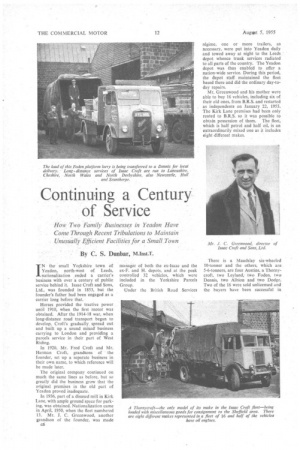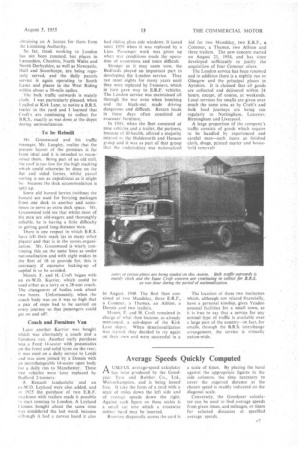Continuing a Century Of Service
Page 44

Page 45

If you've noticed an error in this article please click here to report it so we can fix it.
How Two Family Businesses in Yeadon Have Come Through Recent Tribulations to Maintain Unusually Efficient Facilities for a Small Town
By C. S. Dunbar, M.Inst.T.
I. N the small Yorkshire town of Yeadon, north-west of Leeds, nationalization ended a carrier's business with over a century of public service behind it. Isaac Croft and Sons, Ltd., was founded in 1853, but the founder's father had been engaged as a carrier long before that.
Horses provided the tractive power until 1910, when the first 'motor was obtained. After the 1914-18 war, when long-distance road transport began to develop, Croft's gradually spread out and built up a sound mixed business carrying to London and providing a parcels service in their part of West Riding.
In 1920, Mr. Fred Croft and Mr. Herman Croft, grandsons of the founder, set up a separate business in their own name, to which reference will be made later.
The original company continued on much the same lines as before, but so greatly did the business grow that the original premises in the old part of Yeadon proved inadequate.
In 1936, part of a disused mill in Kirk Lane, with ample ground space for parking, was obtained. Nationalization came in April, 1950, when the fleet numbered 13. Mr. J. C. Greenwood, another grandson of the founder, was made c6 manager of both the ex-Isaac and the ex-F. and H. depots, and at the peak controlled 32 vehicles, which were included in the Yorkshire Parcels Group.
Under the British Road Services regime, one or more trailers, as necessary, were put into Yeadon daily and towed away at night to the Leeds ' depot whence trunk services radiated to all parts of the country. The Yeadon depot was thus enabled to offer a nation-wide service. During this period, the depot staff maintained the fleet based there and did the ordinary day-today repairs.
Mr. Greenwood and his mother were able to buy 16 vehicles, including six of their aid ones, from B.R.S. and restarted as independents on January 22, 1955. The Kirk Lane premises had been only rented to B.R.S. so it was possible to obtain possession of them. The fleet, which is half petrol and half oil, is an extraordinarily mixed one as it includes eight different makes.
There is a Maudslay six-wheeled 10-tonner and the others, which are 5-6-tonners, are four Austins, a Thornycroft, two Leyland,' two Foden, two Dennis, two Albion and two Dodge. Two of the 16 were sold unlicensed and the buyers have been successful in obtaining an A licence for them from the Licensing Authority.
So far, trunk working to London has nist been resumed, but places in Lancashire, Cheshire, North Wales and North Derbyshire, as well as Newcastle, Hull and Scunthorpe, are being regularly served, and the daily parcels service is again operating to South Lanes and places in the West Riding within about a 50-mile radius.
The bulk traffic outwards is mainly cloth. I was particularly Pleased; when I called at Kirk Lane, to notice a B.R.S. trailer in the yard and I learned that. Croft's are continuing to collect for }I.R.S., exaCtly.as was done at the depot during nationalization.
• •
TO be Rebuilt Mr. Greenwood and his traffic manager, Mr. Langley, realize that the present 'layout of the premises is far from ideal and it is intended to recon--stritet them.Being part of an old mill, the roof is too low for the high stacking' which could otherwise be done on the fiat and sided lorries, whilst parcel sorting is not as expeditious as it blight be because the deck accommodation is split up.
Some old horsed lorries (without the horses) are used for ferrying packages from one deck to another and sometimes to serve as extra deck space. Mr. Greenwood told me that whilst most of his men are old-stagers and thoroughly . reliable, he is having a little .difficulty in getting good long-distance men, There is one respect in which B.R.S. • have left their mark (as in many other places) and that is in the storeszorganiaation. ..Mr. Greenwood i .wisely continuing this on the same lines as under nationalizatiOn and With eight makes in the fleet of 16 to provide for, this isnecessary if excessive locking-up of capital is to be avoided.
Messrs. F. and H. Croft began with an ex-W.D. Karrier, which could be used either as a lorry or a 28-seat coach. The changeover of bodies took about two hours. Unfortunately, when the coach body was on it was so high that a pair of steps had to be carried on every journey so that passengers could get on and off!
Coach. and Furniture Van Later another Karrier was bought which was altentatelY a coach and 'a furniture .van. Another early purchase was a Ford 14-Seater with pneumatics on the-frOnt and solid tyres on the rear; it was used on a daily service' to Leeds and was soon joined by a Dennis with an interchangeable 14-seater open body for a daily Ain to Manchester: These two vehicles were later replaced by Bedford 2-tonnerss A Renault landaulette and an ex-W.D. Leyland were also added, and in 1925 the Purchase of two E.R.F. machines with' trailers made it possible Ii) start running to London. A Leyland Lioness ,bought about the same time was considered the last word, because 7kIthough it had a canvas hood it also had sliding glass side windows. It lasted until 1939 when it was replaced by a Lion. Passenger work was given up when war conditions made the operation of excursions and tours difficult.
Strange as it may seem now, the Bedfords played an important part in developing the London service. They ran most nights for many years until they were replaced by 5-tonners, which in turn gave way to E.R.F. vehicles. The London service was maintained all through the war even when bombing and the black-out made driving dangerous and difficult. Return loads in those days often consisted of evacuees' furniture.
In 1944, when the fleet consisted of nine vehicles and a trailer, the partners, because of ill-health, offered a majority interest to the Holdsworth and Hanson grciup and if was as part of that group that the undertaking was nationalised in August. 194S. The fleet then consisted of la o Maudslay, three E.R,F., a Commer, a Thames, an Albion, a Dennis and two trailers.
Messrs. F. and H. Croft remained in charge of what then became, as already mentioned, a sub-depot• of the Kirk Lane depot. When denationalization was started, they decided to try again oh their own and were successful in a bid for two Maudslay, two E.R.F., a Commer, a Thames, two Albion and three trailers. The new concern started on August 21,. 1954, and has since developed sufficiently to justify the acquisition of four Commer oilers. •
The London service has been resumed and in addition there is a nightly run to Glasgow and the 'principal places in Ayrshire. It is claimed that all goods are collected and delivered within24 hours, except, of course, at weekends. Local services for smalls are given over much the same area as by Croft's and bulk load journeys are being run regularly to Nottingham, Leicester, Birmingham and Liverpool. •
A large proportion Of the company's traffic consists of goods "which require to be handled by experienced and careful men—such items as finished cloth, drugs, printed matter and household removals The location of these two businesses which, although not related financially, have a personal kinship,' gives Yeadon unusual facilities for a small town, as it is true to say that a service for any normaltype of traffic is available over a large part of the country—in fact, for smalls, 'through the B.R.S. interchange arrangement, the service is virtually nation-wide,




































































































